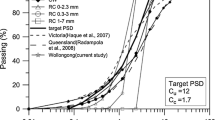Abstract
This paper presents an analysis of a new railroad track design based on substructure containing a double layer of geocells plus an additional geogrid layer for application on a new rail line being constructed. This new line is designed to accommodate both passenger and freight operations. The analysis looked at the applicability of the proposed design to the track substructure conditions on this new line with a primary emphasis on the bearing strength of poor subgrade locations on the new line. The analysis approach used Beam on Elastic Foundation theory to generate stresses on the top of the ballast layer and top of sleeper and then follow-up analysis to include use of test results to analyze the distribution of these stresses through the substructure and the determination of the subgrade bearing stresses. These bearing stresses were then compared with the strength of soils representative of those found on the proposed line segment. Based on the results of the analyses, the proposed substructure design (with 2 geocell layers and one geogrid layer) was found to significantly reduce stresses on the subgrade so that the proposed track was appropriate for use on even the poorest soil types identified on this line segment. This is because of the improved strength and stiffness characteristics of the geocell reinforced ballast layer.







Similar content being viewed by others
Notes
The AREMA dynamic wheel load formula was developed in English units but has been converted to SI units in this paper.
Rail seat force on sleeper is the force on the top of the sleeper at the rail seat, where the rail sits on the sleeper. Note these forces are per rail and per sleeper.
The Talbot equation of distribution of stress through the ballast was developed in English units but has been converted to SI units in this paper.
The Amtrak installation also had a geogrid layer below the geocell layer, separated by a 125 mm layer of sub-ballast.
Reference (Leshchinsky and Ling 2013a) reported that the double-reinforced embankment reached the tensile limit for the loading frame.
References
Chrismer, S.: “Tests of GeoWeb® to improve track stability over soft subgrade”, AAR Technology Digest TD 97-045, December 1997
Chrismer, S.: “Cost comparisons of remedial methods to correct track-structure instability”, TTCI Technology Digest, 99-009, March 1999
Gräbe, H.: Geosynthetics for improving poor track formations, Transportation Research Board, Washington DC 2010
Kae, J. K.: “Geotechnical and field measurements at Amandelbult Test Section”, Spoornet (South African Railways) Technical Report, June 2007
Kerr, A. D.: “Fundamentals of railroad track engineering”, Simmons Boardman Books, Omaha, NE, 2003 pp. 86–111
Leshchinsky, B. and Ling, H.: “Effects of geocell confinement on strength and deformation behavior of gravel”, Journal of Geotechnical and Geoenvironmental Engineering, ASCE February, 2013a
Leshchinsky, B. and Ling, H.: “Numerical modeling of behavior of railway ballasted structure with geocell confinement”, Geotextiles and Geomembranes, February, 2013b
“Manual for railway engineering”, American Railway Engineering and Maintenance of Way Association, Lanham, MD, 2018
Newman, R. R., Zarembski, A. M., Resor, R. R.: “Burlington Northern’s assessment of the economics of high capacity/heavy axle load cars”, Bulletin of the American railway engineering association, bulletin 726, Volume 91, (1990)
Newman, R. R., Zarembski, A. M., & Resor, R. R.: “The effect of increased axle loads on maintenance of way and train operations at Burlington Northern”, International Heavy Haul Association /Transportation Research Board Workshop, Vancouver, B.C., June 1991
Palese J. W., Hartsough C. H., Zarembski A. M., Thompson, H., Ling, H. L. Pagano W.: “Life cycle benefits of subgrade reinforcement using geocell on a high speed railway- a case study”, American Railway Engineering Association Annual Conference, Indianapolis, IN, September 2017
Satyala, S., Leshchinsky, B., Hanc. J., and Neupane, M., “Use of cellular confinement for improved railway performance on soft subgrades”, Geotextiles and Geomembranes, 2018
Talbot, A. N.: “Stresses in railroad track- the Talbot reports”, American Railway Engineering Association, Washington DC, 1980 pp348
Zarembski, A.M., Bonaventura, C.S.: “Dynamic effects of track surface condition on vertical wheel/rail forces and energy consumption”, ASME/IEEE/AREMA Joint Rail Conference 2010, Urbana, IL, April 2010
Zarembski, A.M., Palese, J.W., Hartsough, C.H., Ling, H.I., Thompson, H.: Application of geocell track substructure support system to correct surface degradation problems under high speed passenger railroad operations. J Transport. Infrastruct. Geotechnol. 4(4), 106–125 (2017)
Author information
Authors and Affiliations
Contributions
Dr. Zarembski is the sole author of the paper. He is responsible for all research activities, analyses, and writing of the paper.
Corresponding author
Ethics declarations
Conflict of Interest
The author declares no conflict of interest.
Additional information
Publisher’s Note
Springer Nature remains neutral with regard to jurisdictional claims in published maps and institutional affiliations.
Rights and permissions
About this article
Cite this article
Zarembski, A.M. Analysis of Geocell-Based Track Design for the Reduction of Stresses in the Track Substructure. Transp. Infrastruct. Geotech. 7, 390–404 (2020). https://doi.org/10.1007/s40515-020-00129-4
Accepted:
Published:
Issue Date:
DOI: https://doi.org/10.1007/s40515-020-00129-4




